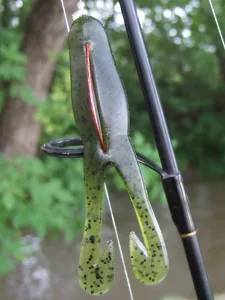
Summer Success. Largemouth bass and other big predators will target larger critters that enter the water and are a bit more vulnerable when they’re swimming. Simonson Photos
By Nick Simonson
As a kid at Boy Scout camp, I watched the large leopard frogs leap from the grass as my troop wandered around the stock ponds at the fish hatchery’s rearing facility located near our day camp location north of town. A trio of us jumped back in surprise as the water swirled off to our right in a startling splash as one of the largemouth bass in the pond inhaled a fleeing amphibian swimming just below the surface. It was then the inkling that frog-type surface baits might prove successful in my efforts for largemouth in the future.
Fast forward a decade or two and summertime began to present one of my favorite methods of landing lunker largemouths; by throwing out a soft plastic frog and reeling it back to the boat, legs paddling and making an easily-found vee trail in the water for bass to follow. But these bigger morsels aren’t the only ones that attract summertime predators, as other larger lures represent major mouthfuls for hungry predators like bass, pike and muskies this time of year.
Amphibious Arsenal

Simonson Photos
In addition to surface baits like the Zoom Horny Toad and the Scum Frog, there are a wide variety of soft plastic frog imitators that are either worked quickly back to the boat along the edge of, or slowly navigated through the summertime slop of surface weed mats, lily pads, or reed beds, and sometimes all three mashed together. Additionally, larger lizard-style baits of five or six inches do a great job of imitating salamanders during the summer season and can be crept across the surface in a similar manner or weighted and worked down low to trigger bites beneath the green canopy. A selection of both frog and salamander style baits are a must-have for targeting large summer bucketmouths.
Mouse in the House
In a similar vein, mice can present a solid staple for bigger fish, especially pike. Mouse imitators like the SPRO Rat and the Livetarget Hollow Body Mouse can be cast out and worked in a similar manner to draw the attention and ire of hungry pike and even muskies. Additionally, larger mouse flies have been known to turn big trout on whenever these rodents are found in abundance. Bigger patterns with undulating tails can be cast on an eight-weight fly rod where larger trout are present, and jumbo offerings can be hurled on a ten-weight for pike and muskies as well. Mice represent a bumper feast for hungry predators and when they “hatch,” the action can be tough to match.
Duck and Cover
Finally, summer presents a surface smorgasbord for muskies in the form of ducklings in all different varieties. On a lake where the fish of 10,000 casts is present, it is not uncommon to watch a group of ducklings dwindle from ten birds in mid-spring to about five or six by the end of summer. While some succumb to natural causes, a number of these prey items quickly become the target of resident muskies and whipping out duck-type lures such as the Savage Gear 3D Suicide Duck can produce explosive topwater strikes from muskies when the time is right and ducklings are plentiful and growing.
Admittedly, these lures aren’t going to always be a go-to for the particular species they are made for, and most exploit a surface element to catch the attention of feeding fish. However, when employed at the right time and in the right place, these big bites can produce massive, memorable strikes and are always worth a cast or two simply for that excitement which mirrors the swirling death I first witnessed so many years ago that got me thinking a bit bigger for fun summertime angling efforts.
Simonson is the lead writer and editor of Dakota Edge Outdoors.
